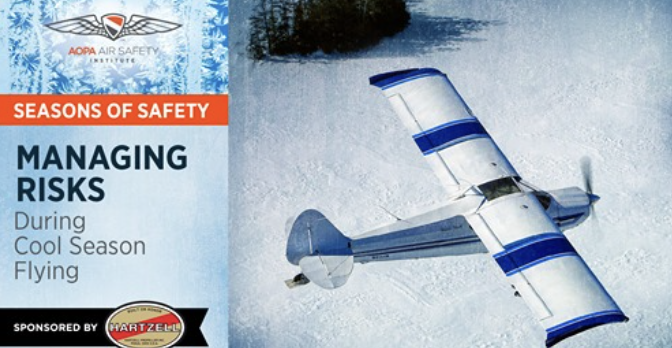At Hartzell Propeller, we’re passionate about promoting proficiency among pilots of all experience levels. That’s why we’re proud to sponsor the AOPA Air Safety Institute’s (ASI) new webinar series, “Seasons of Safety.” The four-part live webinar series focuses on the seasonal challenges of staying a safe, proficient pilot.
The latest webinar, “Managing Risks During Cool Season Flying,” highlights the critical risk management steps pilots need to take when flying in the winter months. James-Paul “J-P” Dice, CFI and Chief Meteorologist at WBRC-TV in Birmingham, Alabama, presented helpful tips and reminders for dealing with hazardous winter flying conditions such as icing, thunderstorms, and low visibility.
Here’s a quick recap of some of the top tips covered in the webinar:
Know the Common Risk Factors for Weather-Related Accidents
Weather is often cited as a cause or contributing factor in general aviation accidents. But, in many cases, weather-related accidents are avoidable with effective risk management. Be vigilant against the following common risk factors:
- Get-there-itis. Don’t allow guilt or pressure from family, passengers, or employers to get in the way of good decision making. When making the go/no-go decision, focus on risk management, not adhering to a certain itinerary.
- “I have done it before and survived.” – You may have flown in similar weather before, but that doesn’t mean it was a good idea—or that you can safely do it again.
- No backup or escape plan. As J-P says, the weather does not always behave as forecasted. Always have a backup plan or alternate in case you run into poor weather.
- You don’t know what you don’t know. Acknowledge that there will be gaps in your knowledge and experience. Establish your own personal minimums for flying and stick to them!
Understand the Pros and Cons of Cool Season Flying
Cold weather flying offers a unique set of challenges, along with some rewards.
Advantages:
- Lower density altitude means better, more efficient aircraft and engine performance.
- In many cases, the ride is smoother for passengers.
- Strong tailwinds are usually available if you’re heading in the right direction.
- Cooler temperatures on the ground for aircraft with no air conditioning.
Disadvantages:
- Low overcast means obscured visibility and more IFR days.
- Icing conditions, which can spell disaster for small aircraft.
- Winter thunderstorms and other cold-weather hazards such as snow, sleet, freezing precipitation, and frozen ice pellets.
Manage Weather Risks
Be sure you’re monitoring the weather frequently and using the best weather data tools at your disposal.
- Be weather aware. Check and monitor the weather often in the time leading up to your flight. J-P says he looks at weather information days in advance. As his flight gets closer, he looks at higher resolution data to take a deeper dive into the weather information.
- Use a variety of weather data tools. These days, pilots have more weather data tools available than ever before. J-P says 99% of every tool he uses is available free of charge on the internet.
- Read forecast discussions. J-P recommends making it a habit of reading the forecast discussions for both your departure and your destination. These will give you a good idea of what the meteorologists at the local weather service offices are thinking when they made the forecast.
- Use datalink weather wisely. Datalink weather (either ADS-B or SiriusXM) is a fantastic tool for pilots, but it has limitations, including transmission delay and lower resolution. J-P says the transmission delay could be between 5 minutes up to 20 minutes. He recommends using it as a strategic tool, but not necessarily as a tactical tool to pick your way around storms in flight.
- Listen to other pilots and ATC. Pay attention to PIREPs, which can give you accurate in-flight information about unfavorable weather.
Planning your flight
Winter flying requires extra time for pre-flight planning and aircraft preparation. Here are some tips to consider when getting ready for a cold-weather flight:
- Assess your aircraft. Know how your aircraft is equipped for cold weather flying. Does it have anti-ice or deice systems? What about a TKS system, wing or propeller boots, or pitot heat? Remember that even well-equipped aircraft can be challenged by severe weather and icing.
- Assess your risks as a pilot. Just like airplanes, pilots need to be equipped to handle the weather. What’s your experience in cool-season flying? Are you proficient? Make sure you’re mentally prepared for the conditions you may encounter in the skies.
- Make an escape plan. Always have an out. It’s best to have a plan B (and C and D) in case of an emergency or if things don’t go according to your original plan. If a plan B isn’t available, you can always fly another day.
Watch the full webinar for more detailed weather-related tips and resources related to cool season flying.
Looking for more flying safety tips? View all the Seasons of Safety episodes here.
